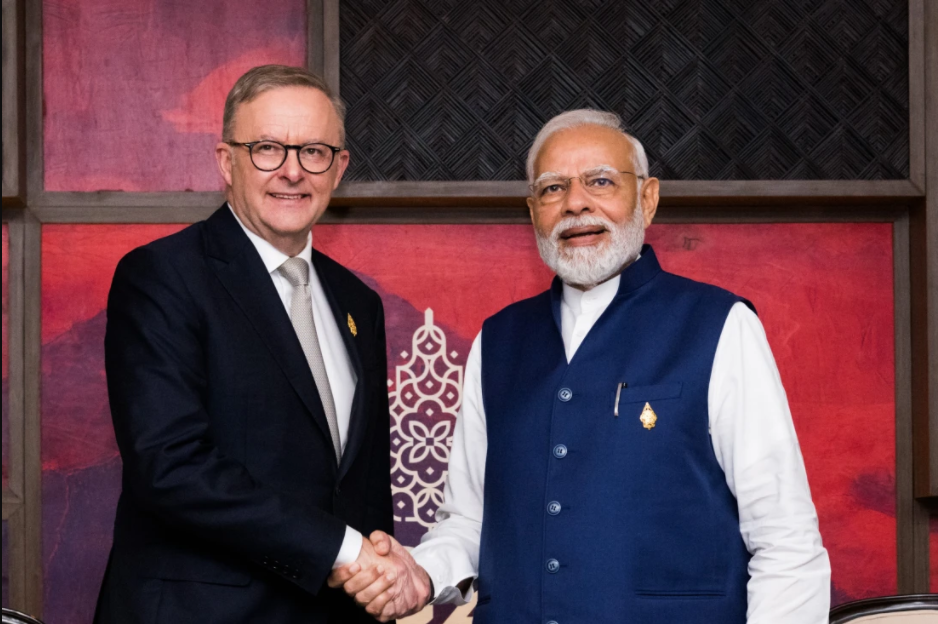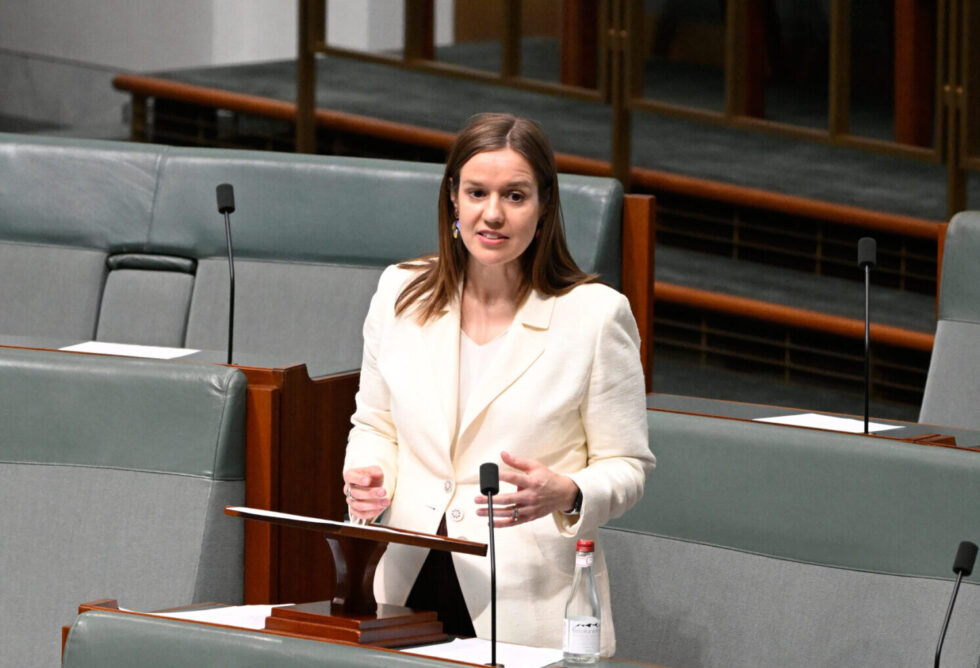
Prime Minister Anthony Albanese’s visit to India this week, along with his trade and resource ministers and some of the country’s most high-profile chief executives, is a serious show of intent – and it follows a stream of similar recent trips by other cabinet ministers and university leaders.
They are motivated by an increasingly important bilateral relationship and what the Department of Foreign Affairs and Trade describes as an “enormous economic opportunity”.
India is on a tear. The IMF expects the country’s gross domestic product to grow by 6.1 per cent this year and says India is the bright spot in the global economy while other major markets slow. Last year, India passed the UK to become the world’s fifth-largest economy by nominal GDP. Britain’s Centre for Economic and Business Research expects it to get to third place behind the United States and China by 2032. That’s less than a decade away.
All of India’s trading partners are keen to get in on the action. Australia, which sees education as a big opportunity now and zero-carbon technology collaboration in the future, has a few advantages including an interim trade deal signed last year, India’s first since 2011. As well as trade opportunities, New Delhi and Canberra also have shared geopolitical interests that reflect a mutual wariness about Beijing.
“India is not another China,” says ANZ CEO Shayne Elliott, who is among those travelling with the PM this week. “But there is equal opportunity there, given the vastness of the economy and the size of the consumer market.
“We are quite hopeful there will be a new dawn for the Australia-India relationship.”
Elliott, who has been going to India for 30 years, acknowledges the country has had a knack for disappointing by missing growth expectations in the past. He thinks it is different this time, with the government of Narendra Modi intent on making it easier for foreign firms and business in general with “quite dramatic” changes on the ground.
ANZ’s institutional business is growing in the country, and it employs 7500 people in a services hub that Elliott says gives the bank a competitive edge, thanks to top-notch tech skills.
The two-way trade between the countries is Australia’s sixth largest. India’s Commerce and Industry Minister, Piyush Goyal, is bullish about the trade prospects between the two nations and insists that bilateral trade could be boosted to an astounding $US100 billion ($151 billion) by 2030 from the current level of about $US27.5 billion – double what Australian pundits are hoping for.
Here is why there is plenty of room for growth.
1. Demographics
Next month, the United Nations is expected to announce that India has passed China as the world’s most populous country. About 26 million babies were born in India last year, compared with about 9.56 million in China where the population has shrunk for the first time. In 2021-22, foreign direct investment reached $US84.8 billion, the highest ever.
The birth rate mirrors a key difference between the world’s two most populous countries. Only 7 per cent of India’s population is 65 or older, compared with 14 per cent in China. The share of Indians who are 65 will not get to 30 per cent until 2100.
In China, retirees will account for 39 per cent of the population by 2050. A growing working-age population puts pressure on India to create jobs, but it also provides opportunities for economic growth – and a growing middle class will drive up consumption of local and imported goods. People Research on India’s Consumer Economy (PRICE) suggests one in three Indians is now middle-class and this will double to two in three by 2047.
India is also liberalising. It is still largely an agricultural economy dominated by millions of small farmers who produce crops and milk for domestic consumption, and collectively they have massive political clout. In 2020, their representatives persuaded the Modi government to bow out of a major multilateral trade deal between 15 Indo-Pacific countries including Australia – the Regional Comprehensive Economic Partnership – at the last hour.
However, there are signs India is overcoming its protectionist tendencies, after it signed an interim Economic Co-operation and Trade Agreement (ECTA) with Australia last year. The grab-bag of tariff reductions and visa changes won’t affect Indian dairy farmers, but it is an important signal of New Delhi’s intent, observers say. It is also great timing, given the industrialisation push embodied in Modi’s Make in India campaign requires rapid skill development and education, and Australia is well-placed to provide.
Australia has a first-mover advantage as India liberalises, says Melbourne-based Asialink Business chief executive Leigh Howard. “The ECTA is a game changer; there aren’t many other nations with a trade agreement which provides market access like ours,” he says.
ANZ Research has forecast goods exports and imports to grow about 10 per cent annually under the ECTA while services will increase about 15 per cent each year.
“This will likely take the total bilateral trade to $US32 billion by 2025, and to $US52 billion by 2030. However, these estimates also show that for such a large trade opportunity to be realised, efforts to enhance trade relations will need to be significantly scaled up,” ANZ economists say.
2. Education
Wanted: 35 million university places. The Indian government wants to double the percentage of students enrolled in higher education by 2035. Australia is among the countries it has tapped to assist.
About 87 per cent of the services Australia exports to India are education-related and are worth $6 billion to the economy, according to the Department of Foreign Affairs and Trade. Pre-COVID-19, the number of Indian students in Australia trailed those from China, the biggest market, but that could change soon.
Last year, 148,174 international students started at Australian universities. This included 47,428 from China, an 11.3 per decline on the year before, and 29,436 from India, up 160 per cent.
Deakin and Wollongong universities are tipped to establish Indian campuses after being given the green light by New Delhi, which has also decided to recognise dual degrees.

The ability to split study time between two countries is expected to encourage more students to consider a stint in Australia – particularly with the carrot of residency dangled at the end. Last week, RMIT launched a joint academy with the Birla Institute of Technology and Science (BITS) to offer four engineering split-degree programs. The two institutions hope thousands of Indian students will sign up.
India also wants to move its institutions up the world rankings – PhD candidate Jyoti Arora is one of 63 researchers awarded an Australia India Research Students Fellowship. The bilateral program, the first of its kind, is funded by the Department of Education and led by the Australia India Institute. “I’m keen to find out what strategies Australian universities use to both attain a high ranking and then keep it,” Arora says.
Advertisement
3. Skilled migrants
The Indian diaspora in Australia has grown five-fold in the past 20 years. As of the 2021 census, there were 673,352 Indian-born people living here. India is No. 2, after the UK, for countries of birth outside of Australia, and it is our largest source of skilled migrants.
The ECTA is expected to boost migration by smoothing pathways after higher education. It coincides with Labor undertaking the biggest shake-up to the immigration system in decades, amid a historic worker shortage.

However, more should be done to attract and allow for more permanent skilled workers from India, says Lisa Singh from the Australia-India Institute.
“We have skills gaps and if we are going to address those in both the short and long term, we have to look to India, to its tech talent and its young workforce, to help meet Australia’s business and social needs,” says Singh, a senator for Tasmania from 2011 to 2019 and Australia’s first female federal parliamentarian of Indian origin.
“India has some of the best and brightest in the world, and we should be offering paths to permanent migration and more mobility options for people to move between the two countries,” Singh says.
4. Old and new energy ties
India is a big buyer of Australian coal. In 2021, Australia’s metallurgical coal exports to India, the world’s largest customer, were worth $12.1 billion, and it was the fourth-biggest buyer of thermal coal, used mostly to produce electricity, after Japan, South Korea and Taiwan.
Australia exported $63 billion of coal globally in 2021. About 21.5 per cent (valued at $13.7 billion) of these exports went to India. The Department of Industry, Sciences and Resources expects India’s thermal coal imports to increase this year and next, thanks to rising electricity demand that’s been driven largely by industrial users as manufacturing expands.
Advertisement


India is the world’s largest energy market and as it accelerates its transition to renewables, there are many views on how Australia can contribute and benefit. Hydrogen features in most of these.
One of those leading the charge is Indian multinational conglomerate company Reliance Industries. Its chairman, Mukesh Ambani, has spoken about participating in international markets in relation to hydrogen and green power.
Reliance has considered building a green hydrogen manufacturing plant in Australia, a plan that mirrors the ambitions of Andrew Forrest’s Fortescue Future Industries.
Another related area of mutual benefit is critical minerals needed for clean energy technologies, such as lithium and copper. The Indian government wants to work with Australia across all elements of the supply chain, from mining resources to the production of solar panels and batteries.
5. China
India’s External Affairs Minister, S. Jaishankar, describes New Delhi’s relationship with Beijing as “abnormal”.
China is vying with the US for the rank of India’s largest trading partner but with thousands of soldiers massed on either side of the Sino-Indian border, India has been increasingly keen to deepen relationships with democracies that can help keep peace in the neighbourhood.




